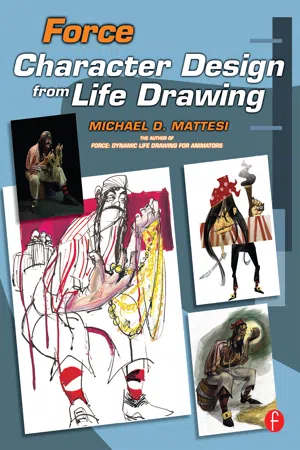
eBook - ePub
Force: Character Design from Life Drawing
Mike Mattesi
This is a test
- 256 pages
- English
- ePUB (mobile friendly)
- Available on iOS & Android
eBook - ePub
Force: Character Design from Life Drawing
Mike Mattesi
Book details
Book preview
Table of contents
Citations
About This Book
Design creative characters inspired by real people. Let Mike Mattesi show you how to use life drawing to discover the poses, features and personalities which form the basis of character and then build, develop and 'PUSH' your drawings to new heights of dramatic and visual impact for believable characters audiences can relate to. Packed with color illustrations and photographs of the models who inspired them. With step-by-step explanation of how the characters were developed and exercises for you to sharpen your skills this is everything you need to bring your characters to life.
Frequently asked questions
How do I cancel my subscription?
Can/how do I download books?
At the moment all of our mobile-responsive ePub books are available to download via the app. Most of our PDFs are also available to download and we're working on making the final remaining ones downloadable now. Learn more here.
What is the difference between the pricing plans?
Both plans give you full access to the library and all of Perlego’s features. The only differences are the price and subscription period: With the annual plan you’ll save around 30% compared to 12 months on the monthly plan.
What is Perlego?
We are an online textbook subscription service, where you can get access to an entire online library for less than the price of a single book per month. With over 1 million books across 1000+ topics, we’ve got you covered! Learn more here.
Do you support text-to-speech?
Look out for the read-aloud symbol on your next book to see if you can listen to it. The read-aloud tool reads text aloud for you, highlighting the text as it is being read. You can pause it, speed it up and slow it down. Learn more here.
Is Force: Character Design from Life Drawing an online PDF/ePUB?
Yes, you can access Force: Character Design from Life Drawing by Mike Mattesi in PDF and/or ePUB format, as well as other popular books in Informatik & Digitale Medien. We have over one million books available in our catalogue for you to explore.
Information
Chapter 1
Force with Character
In this first chapter, we are going to experience the risk of pushing our drawings to their forceful extremes. Why? Because pushing poses helps you define character. How far can a drawing go before it falls apart? In what direction do I push the pose? Let’s investigate these and other questions in our search for answers.
The golden rule I abide by in designing from life is that the drawing must work or function the way my subject did. So, if it is a figure, it has to follow my rules from the first book. Rhythm must continue through the figure in discussion. Does my understanding of the figure’s rhythms come through all of my other opinions?
So, as a Force refresher, the arrows in the following diagrams represent the lines you draw with. Each line is a force. In my book Force: Dynamic Life Drawing for Animators, I discuss in great detail how force works and the pitfalls that artists fall into that disrupt force in their experience. These diagrams show how the abstraction of force operates and how we can manipulate it.
The image on the left shows a weak amount of applied force, the orange arrow, pushing upon the dark blue directional force. If we take the same directional force and apply more force to it as shown in the right diagram, see how much more curved it becomes.

The rhythm on the left side of the page is weaker simply because the angle of applied force, represented here by the orange arrow, is weaker. On the right, we can see an illustration of a more dramatic rhythm because the applied forces are on much stronger, forty-five degree angles. I am going to walk you through this chapter starting with more subtle drawings of opinion to clear and loud exaggerations.

This drawing presents subtle opinion. The arm’s leftward stretch is in opposition to that of the lower belly. My experience here is clearly spoken without any real exaggeration. It states my intent without screaming. Notice the line weight in the lower abdomen. I added more pressure to my marks because of my thinking about the forces and gravity found there.

Force is starting to get extreme. The upward thrust in the hip is the obvious main focus. Knowing this is what allows me to push that main idea. Without that thought, I cannot push an opinion. The strength of that curve is what makes it feel so extreme.

The pulling inward with the hands and curving of the back help the body in one clear purpose. The trick here is to be aware of the relationship of these forces. The arms are brackets of force from the back to the shoulders, down to the elbows, and into the hands. The unobvious lies in being sensitive to this experience. I had to allow the drama and energy of this pose to affect me for the drawing to have this impact. If I disconnect myself from it and maybe confronted the experience through the act of measuring, I would have lost this feeling in the drawing. It is his effort that I wanted to empathize with.

Rhythm is of primary concern to this experience. Force number one moves down to the hips and splits off into the legs. I used the orange arrows here to represent applied force and how it connects forces. The thrust in the upper body, linked into the arms and hands, must work here in conjunction with the hips and legs. I love the gnarled right hand. My immediate impression came across in the drawing. This drawing was achieved with a Lyra 9B lead crayon.

Weight was the main idea here. With this in mind and as my main story point, I pushed that thought into the belly, the hanging of the arms, the drop of the legs, and the pull on the feet. The forward charge of the head also assists in this sensation.

Here the main idea of the story is the lunge in the right shoulder. You can see my effort placed into this moment in the pose. From there, force slides its way down to the feet and down through the right arm.
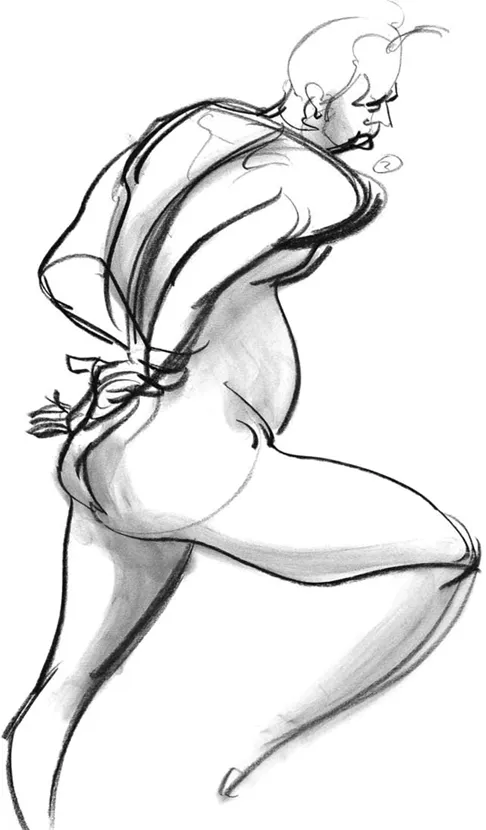
This one-minute drawing shows how powerful the simplicity of force is. The curves of force in the upper body, legs, and arms relate to one another to keep the figure connected.
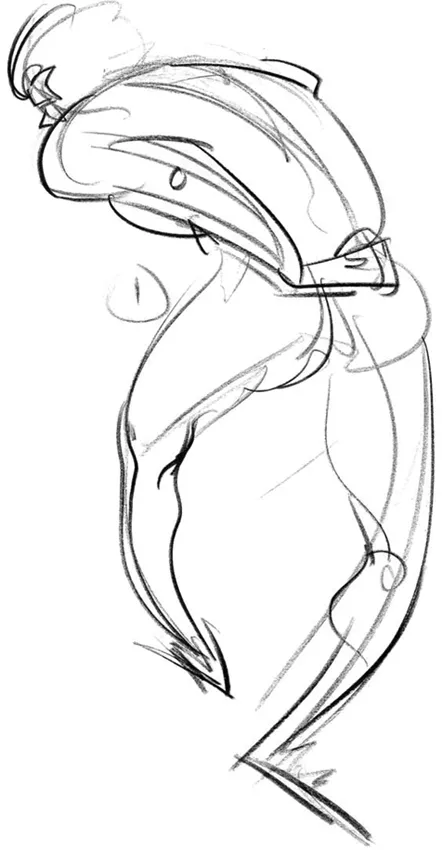
The meandering right shoulder of the model creates an interesting shape to that area of her body. The overlapping in her knees becomes an evident trick of line. The fingers of her left hand feel fluid, thick, and delicate.
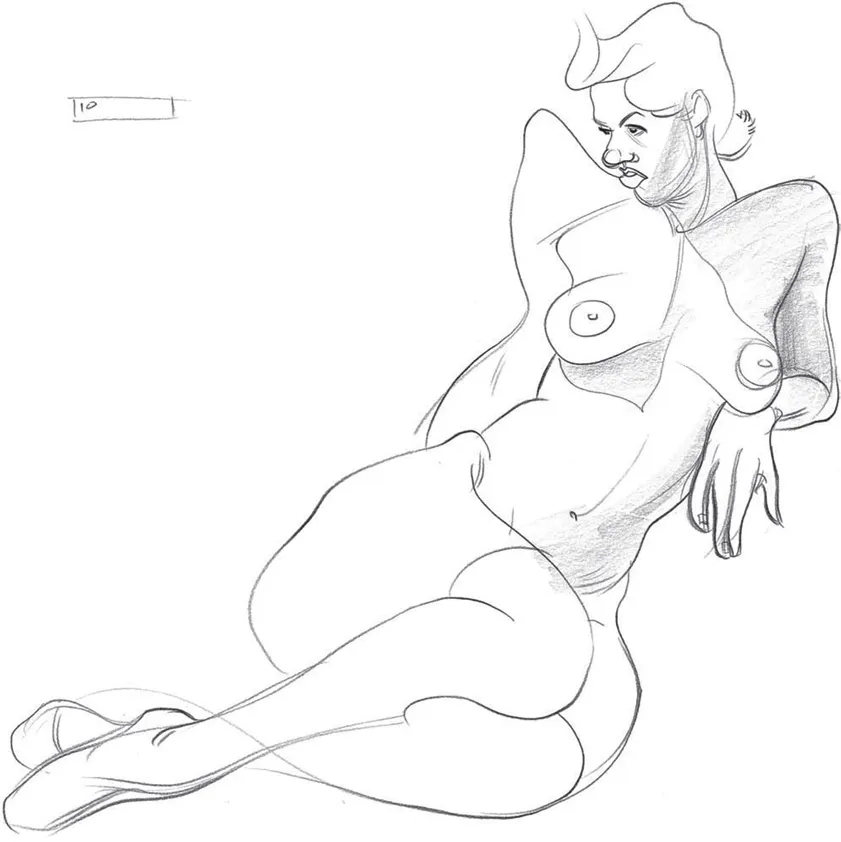
The main expression here is the leftward momentum in the back. You can see by the way I reacted to the arms that I was aware of the muscular tension found here.
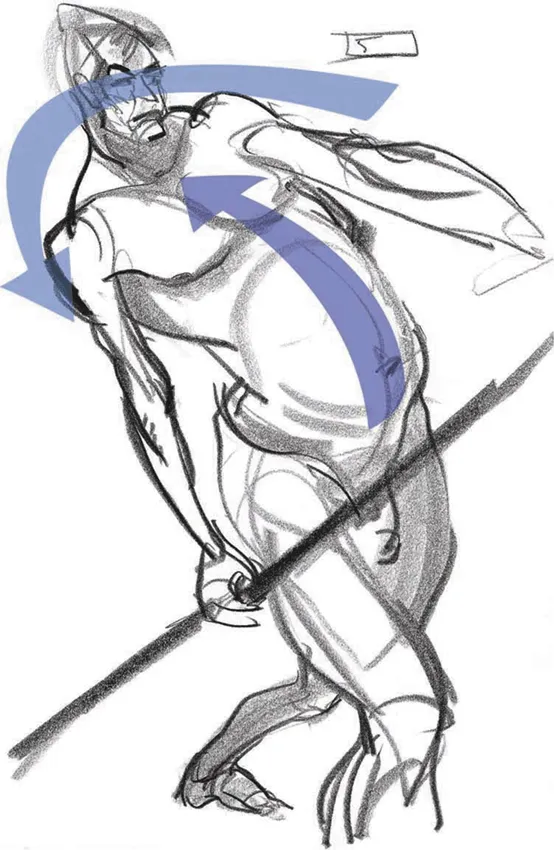
So the main objective in this drawing was the massive size and thrust of energy in the closer shoulder. Notice the change in idea from one hand to the other. There is an interesting story here between the face and model’s left hand. The almost parallel orientation between his left hand and face creates a unity.

Here the opposite directions in force were the priority. The leftward thrust of the back and the suspension bridge of the arms looming rightward pull this figure on a horizontal line. The angle of the back left foot anchors the figure down onto the floor.
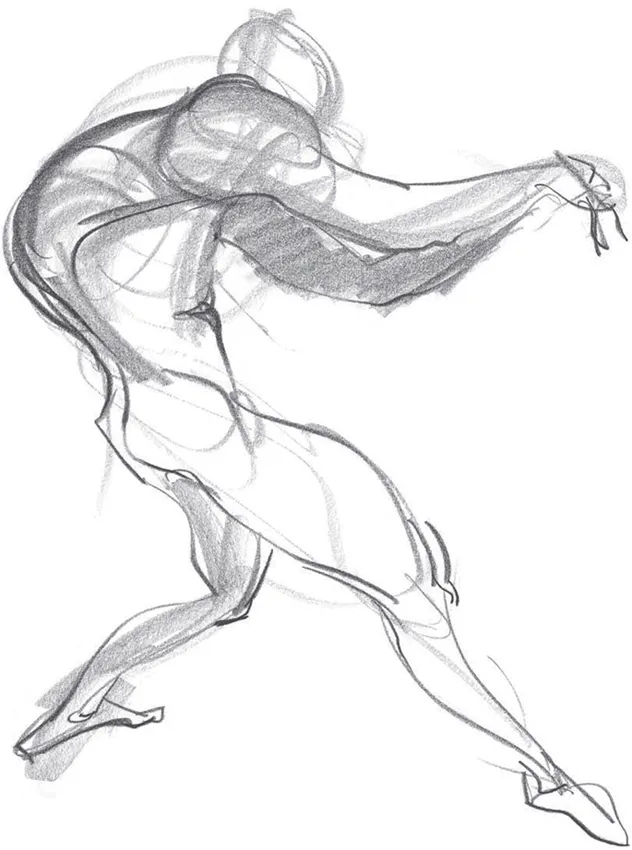
The shoulder pushing its way into the model’s face was my first thought here. Next was the curiosity behind the relationship between the two arms. There is a repetition in the hands and wrists that somehow completes the pose.

AMAZING ANGLES
I covered a great deal of the power of the curve in Force: Dynamic Life Drawing for Animators. Now let’s discuss straight lines relative to force. A perfect vertical or horizontal on the page is far less dramatic than the forty-five degree angle. This is the most dramatic angle on the page. I use angles in an abstract manner. I do not draw for the sake of seeing and measuring angles. Implement angles as another tool for a higher purpose. Don’t make angles and measuring the end result of your figure drawing experience!
There are two ways to use angles. The first is what I describe at the beginning of the chapter. Angles are actually created by the relationship between two forces. The angles are applied forces. These applied forces are created by the strength of the curvature of the directional forces.
The second is the abstraction of just an angle on the page. The force here to consider relative to an angle is gravity and how angles relate to each other on the page.
Visually this may not be very exciting but the simplicity behind its application is pure power. There is for me a sense of imagined gravity in the world of the page. I have indicated that with the orange arrows. With that in mind, the vertical thought falls, the horizontal lays flat, and the diagonal at forty-five degrees has the most movement and drama. It fights gravity and redirects it from one location to another. Think of the orange arrow as water.

Let’s look now at a perfect, vertical, h...
Table of contents
- Cover
- Halftitle
- Title
- Copyright
- Contents
- Special Thanks
- Foreword
- Preface
- Key Concepts
- Chapter 1. Force with Character
- Chapter 2. Space with Character
- Chapter 3. Shape with Character
- Chapter 4. Costume with Character
- Chapter 5. Reportage with Character
- Chapter 6. Animals with Character
- Closing
- Artist Bios
- Index
Citation styles for Force: Character Design from Life Drawing
APA 6 Citation
Mattesi, M. (2012). Force: Character Design from Life Drawing (1st ed.). CRC Press. Retrieved from https://www.perlego.com/book/1626620/force-character-design-from-life-drawing-pdf (Original work published 2012)
Chicago Citation
Mattesi, Mike. (2012) 2012. Force: Character Design from Life Drawing. 1st ed. CRC Press. https://www.perlego.com/book/1626620/force-character-design-from-life-drawing-pdf.
Harvard Citation
Mattesi, M. (2012) Force: Character Design from Life Drawing. 1st edn. CRC Press. Available at: https://www.perlego.com/book/1626620/force-character-design-from-life-drawing-pdf (Accessed: 14 October 2022).
MLA 7 Citation
Mattesi, Mike. Force: Character Design from Life Drawing. 1st ed. CRC Press, 2012. Web. 14 Oct. 2022.